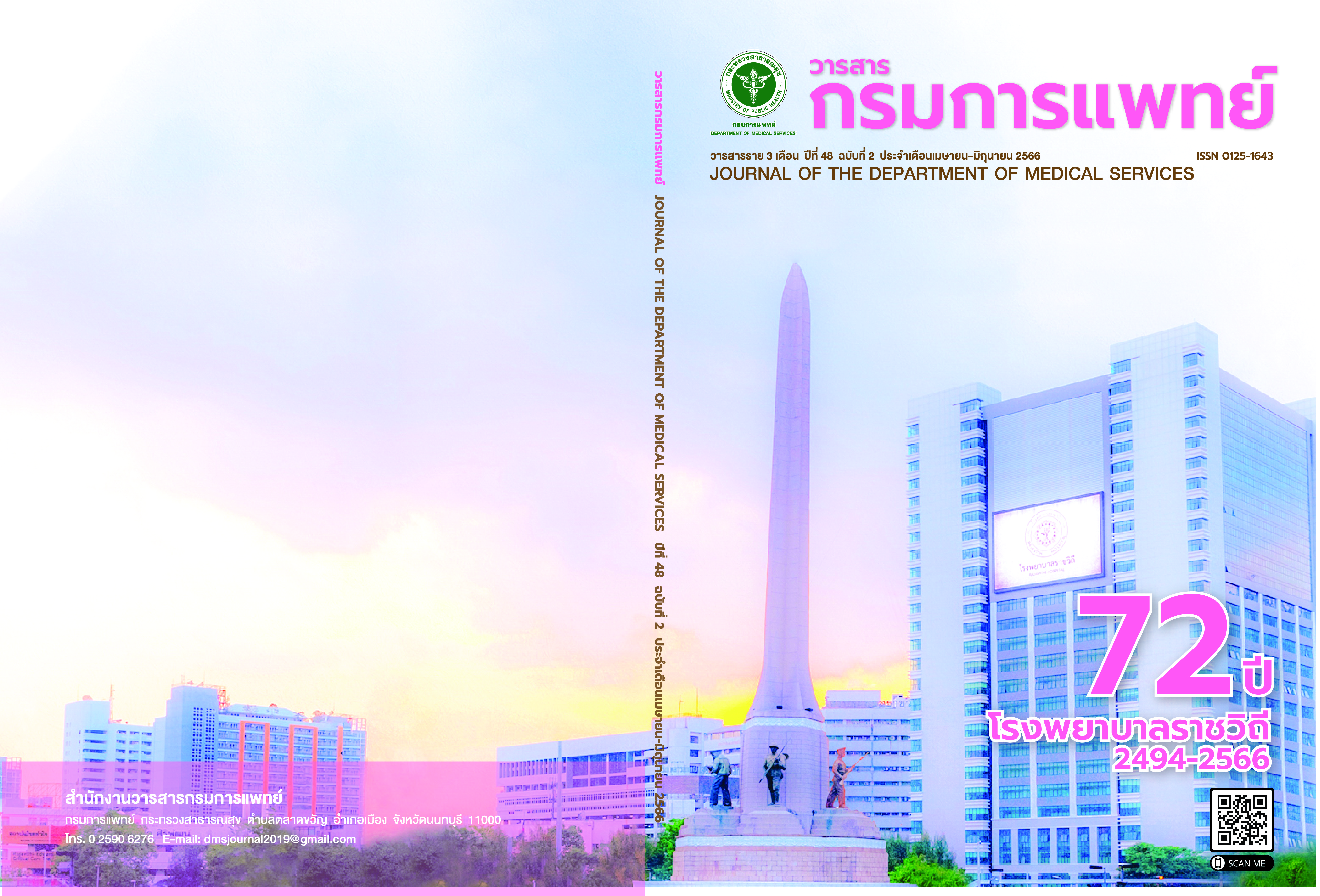Influence of Textured Surface Insoles on Postural Control in Older Adults
DOI:
https://doi.org/10.14456/jdms.2023.22Keywords:
Textured insole, Older adults, Postural control, Wii Balance Board, BTS G-sensorAbstract
Background: The loss of plantar cutaneous sensation in the feet is one of the age-related deteriorationsassociated with impaired balance control, increased postural sway, and an increased risk of falling. About 33% ofadults over 65 undergo falls, resulting in serious injuries. Textured insoles are a simple and low-cost interventionthat could improve balance in older adults. Objective: This study evaluated and compared the influence of threetextured surface insoles on postural control and gait parameters in older adults with either a history of falls withinthe last three months or a moderate risk of falls. Method: Fifteen participants above 65 years old participated inthis study. All participants were tested under four conditions (using a within-session repeated-measures design) forstatic balance assessment with eyes closed, functional mobility assessment, and spatiotemporal gait assessment:barefoot (control), Textured Insole A, Textured Insole B, and Textured Insole C. Result: The results revealed thatwearing Texture Insole A significantly improved the static balance assessment, but not the functional mobility and spatiotemporal gait parameters. The textured surface insole significantly influenced postural control, especially when using filled polymer used as 12V wire insulation, with hardness Shore A 55.1, a density of 354.84 g/cm3, a diameter of 6 mm, a height of 3 mm, and a center-to-center distance of the protrusions of 9.5 mm. This was defined as TexturedInsole A. Conclusion: Using a textured insole was a simple and low-cost intervention that could decrease posturalsway and improve postural control.
References
Bergen G, Stevens MR, Burns ER. Falls and Fall Injuries AmongAdults Aged ≥65 Years - United States, 2014. MMWR Morb MortalWkly Rep 2016; 65(37):993-8
Pasquetti P, Apicella L, Mangone G. Pathogenesis and treatmentof falls in elderly. Clin Cases Miner Bone Metab 2014; 11(3):222–5.
Sterling DA, O’Connor JA, Bonadies J. Geriatric falls: injuryseverity is high and disproportionate to mechanism. J Trauma2001; 50(1):116-9.
Verrillo RT. The effects of aging on the sense of touch. In: VerrilloRT, editor. Sensory research multimodal perspectives. Hillsdale,NJ: Lawrence Erlbaum Associates; 1993. p. 285–98.
Meyer PF, Oddsson LI, De Luca CJ. The role of plantarcutaneous sensation in unper- turbed stance. Exp Brain Res2004; 156(4):505-12.
Karthikeyan G, Jadav Jayraj S, Narayanan V. Effect of forefoottype on postural stability - a cross sectional comparative study.Int J Sports Phys Ther 2015; 10(2):213-24.
Viseux F, Lemaire A, Barbier F, Charpentier P, Leteneur S,Villeneuve P. How can the stimulation of plantar cutaneousreceptors improve postural control? Review and clinicalcommentary. Neurophysiol Clin 2019; 49(3):263–8.
Wanderley FS, Alburquerque-Sendn F, Parizotto NA, RebelattoJR. Effect of plantar vibration stimuli on the balance of olderwomen: A randomized controlled trial. Arch Phys Med Rehabil2011; 92(2):199–206.
Maki BE, Cheng KCC, Mansfield A, Scovil CY, Perry SD, Peters AL,et al. Preventing falls in older adults: New interventions topromote more effective change-in-support balance reactions.J Electromyogr Kinesiol 2008; 18(2):243–54.
Lipsitz LA, Lough M, Niemi J, Travison T, Howlett H, Manor B.A shoe insole delivering subsensory vibratory noise improvesbalance and gait in healthy elderly people. Arch Phys MedRehabil 2015; 96(3):432–9.
Maurer C, Mergner T, Bolha B, Hlavacka F. Human balance controlduring cutaneous stimulation of the plantar soles. Neurosci Lett2001; 302(1):45-8.
Watanabe I, Okubo J, Medical T. The role of the plantarmechanoreceptor. Annals New York Academy of Sciences 1981;374:855–64
Chen TH, Chou LW, Tsai MW, Lo MJ, Kao MJ. Effectiveness of aheel cup with an arch support insole on the standing balanceof the elderly. Clin Interv Aging 2014; 9:351–6.
Gross MT, Mercer VS, Lin FC. Effects of foot orthoses on balancein older adults. J Orthop Sports Phys Ther 2012; 42(7):649–7.
Corbin DM, Hart JM, McKeon PO, Palmieri-Smith R, Ingersoll CD,Hertel J. The effect of textured insoles on postural control indouble and single limb stance. J Sport Rehabil 2007; 16(4):363-72.
Qiu F, Cole MH, Davids KW, Hennig EM, Silburn PA, Netscher H,et al. Enhanced somatosensory information decreases posturalsway in older people. Gait Posture 2012; 35(4):630-5.
Hatton AL, Dixon J, Rome K, Newton JL, Martin DJ. Altering gaitby way of stimulation of the plantar surface of the foot: theimmediate effect of wearing textured insoles in older fallers.J Foot Ankle Res 2012; 5:11.
Mathsson L, Tejde A, Carlson K, Höglund M, Nilsson B, NilssonEkdahl K, et al. Standing on textured surfaces: Effects onstanding balance in healthy older adults. Br J Haematol 2011;129:363–8.
Li PL, Yick KL, Ng SP, Yip J. Influence of Textured Indoor Footwearon Posture Stability of Older Women Based on Center-ofPressure Measurements. Hum Factors 2019; 61(8):1247–60.
Ritchie C, Paterson K, Bryant AL, Bartold S, Clark RA. The effectsof enhanced plantar sensory feedback and foot orthoses onmidfoot kinematics and lower leg neuromuscular activation.Gait Posture 2011; 33(4):576–81.
Nurse MA, Hulliger M, Wakeling JM, Nigg BM, StefanyshynDJ. Changing the texture of footwear can alter gait patterns.J Electromyogr Kinesiol 2005; 15(5):496–506.
Jellema AH, Huysmans T, Hartholt K, van der Cammen TJM. Shoedesign for older adults: Evidence from a systematic review onthe elements of optimal footwear. Maturitas 2019; 127:64–81.
Zarzeczny R, Nawrat-Szołtysik A, Polak A, Maliszewski J,Kiełtyka A, Matyja B, et al. Aging effect on the instrumentedTimed-Up-and-Go test variables in nursing home womenaged 80–93 years. Biogerontology 2017; 18(4):651–63.
Stel VS, Smit JH, Pluijm SM, Lips P. Balance and mobilityperformance as treatable risk factors for recurrent falling inolder persons. J Clin Epidemiol 2003; 56(7):659-68.
Maki BE, McIlroy WE. The control of foot placement duringcompensatory stepping reactions: does speed of responsetake precedence over stability? IEEE Trans Rehabil Eng 1999;7(1):80–90.
Downloads
Published
How to Cite
Issue
Section
License
Copyright (c) 2023 Department of Medical Services, Ministry of Public Health

This work is licensed under a Creative Commons Attribution-NonCommercial-NoDerivatives 4.0 International License.
บทความที่ได้รับการตีพิมพ์เป็นลิขสิทธิ์ของกรมการแพทย์ กระทรวงสาธารณสุข
ข้อความและข้อคิดเห็นต่างๆ เป็นของผู้เขียนบทความ ไม่ใช่ความเห็นของกองบรรณาธิการหรือของวารสารกรมการแพทย์



